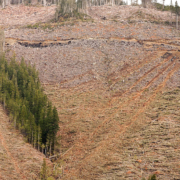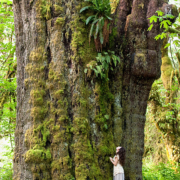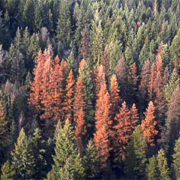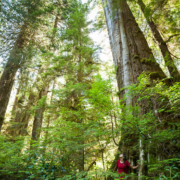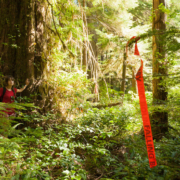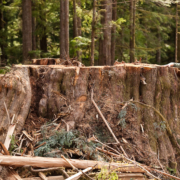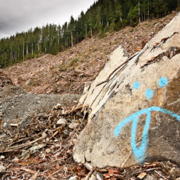Fifteen minutes down a winding gravel logging road outside of Port Renfrew, we spot the telltale flagging tape marking a tree branch and pull over into a small pullout. Across the road, a laminated sign nailed to a tree says “Upper Avatar Grove,” with an arrow pointing up into the forest.
This is it – the reason we’ve driven two hours west of Victoria along Vancouver Island’s rugged west coast to the outskirts of this small former logging town. Stepping into the forest, we take hold of a rope to help us up a steep embankment and onto the makeshift trail, outlined by pink flagging tape.
As we make our way through the rainforest’s undergrowth, ancient red cedars appear almost immediately. The largest trees are 13 metres around and would have been upward of 250 years old when Captain James Cook first set foot on Vancouver Island in 1778. They are the remnants of an ancient forest that once covered much of southern Vancouver Island; it’s estimated only 10 per cent of this ancient forest still remains.
Continuing into the woods, we cross a creek and head up a hillside, passing five or six large cedars as we go. And then, about 20 minutes in, there it is: the piece de resistance, “Canada’s Gnarliest Tree” – a massive red cedar with a bulbous, three-metre burl and serpent-like roots. This is the tree most responsible for sparking a tourism rush in a town once better known for cutting down trees than marvelling at them.
When Ancient Forest Alliance photographer T.J. Watt discovered this stand of ancient cedars in 2009, many of the largest ones were tagged for logging. In a clever marketing move, the alliance dubbed the trees “Avatar Grove,” after the blockbuster James Cameron movie, drawing massive public attention to the trees and ultimately leading to their protection.
These days, visitors to Port Renfrew can pick up a map to the area’s largest trees and set out to explore what’s been coined the Big Tree Capital of Canada. While some of Canada’s largest trees are out of reach of a typical rental car, there are still plenty of accessible giants – aided by the recent paving of the Pacific Marine Circle Route, which allows travellers to drive across the interior of the island and pop out on the east coast near Duncan, rather than doubling back along the same route to Victoria.
After visiting both upper and lower Avatar Grove, which has become such a popular destination that work on a boardwalk is set to begin any day now, we continued on the circle route. About 15 kilometres outside of Port Renfrew, we turn right down a logging road for a few kilometres before reaching the San Juan Spruce, Canada’s largest Sitka spruce tree, standing taller than the Leaning Tower of Pisa at 62.5 metres, with a circumference of 11.6 metres. This tree is so big that if it fell prey to a chainsaw, it could provide enough wood for 333 telephone poles. Thankfully, these days, it’s seeing more camera lenses than chainsaws.
A little further along the circle route, the Harris Creek spruce is the most easily accessible big tree in the area and towers above the forest. As we drive, it’s impossible not to notice the clear cuts that border right on the highway. It is, after all, an old logging road, so the band of trees normally left to hide clear cuts from view wasn’t originally deemed necessary. While not the prettiest sight, it serves to bring the juxtaposition of the area’s past and future into clear view.
“TimberWest owned all the houses in Port Renfrew at one time. It was a logging town,” says Jon Cash, original creator of the “Tall Tree Tour” map and owner of Soule Creek Lodge.
Indeed, most of the forest around Port Renfrew has been logged two or three times – which is precisely why ancient trees that have avoided disease, fire and logging companies for up to 1,000 years have attracted so much attention.
“Last year there was a dramatic increase in tourism. It was my best year ever,” says Cash, who was a chef in Toronto before moving to Port Renfrew 11 years ago. “I don’t think anyone ever expected this amount of people to go through Avatar Grove.”
The discovery of Avatar Grove, combined with the paving of the Pacific Marine Circle Route, has also boosted business at Coastal Kitchen Café, a hip Port Renfrew eatery.
“It’s bringing a different type of clientele. We always attracted a fishing community. But now we’re attracting more Europeans and families,” says cafe owner Jessica Hicks.
It’s the type of crowd that jumps at the opportunity to stay in one of Soule Creek Lodge’s luxury yurts perched high on the San Juan Ridge overlooking the area’s ocean and mountains. The lodge is a homey place where guests take their shoes off at the door and checkout happens at the kitchen counter.
The night before our big tree adventure, we checked into a yurt before heading out to check out the tide pools at Botanical Beach just a few kilometres outside of Port Renfrew. Botanical used to be the town’s main tourist attraction and it’s easy to see why with the sandstone outcroppings, rocky cliffs and colourful tide pool inhabitants, including starfish, sea anemones and urchins.
After hiking the three-kilometre loop trail and exploring the tide pools, we’d worked up an appetite and, luckily, had a three-course gourmet dinner in store back at the lodge – featuring local salmon and crab bought right off the town’s dock. Not only is it one of the best meals we’ve had in years, but it’s also a chance to meet other guests – half of whom Cash estimates come to Port Renfrew specifically to see big trees. “This will have dividends for years to come,” Cash says, while inching his way back to the kitchen.
Down at Coastal Kitchen Café, Hicks also sees the preservation of the area’s big trees as a long-term boon. “In the first two years there were at least 10 people a day asking for Avatar Grove whereas before there was nobody,” she says. “I can see that it’s the future of the community.”
In a town of 200 people, 10 new visitors a day is a big deal. And if you’re one of those 10, you get the thrill of visiting somewhere long before the crowds discover it – but half a millennium after some of Canada’s largest trees laid down roots here.
How to get there
Instead of heading back to Victoria after cutting across Vancouver Island on the Pacific Marine Circle Route, you might want to continue on to Tofino. Here are two more great places to check out big trees:
– On Highway 4, between Parksville and Port Alberni, you’ll find Cathedral Grove, which became a provincial park in 1947 after being donated by well-known forester H.R. MacMillan. Home to ancient red cedar and Douglas-fir trees, some more than 800 years old, Cathedral Grove is one of the most accessible stands of old-growth forest on Vancouver Island, attracting more than one million visitors per year.
– From Tofino, you can take a 15-minute water taxi across to Meares Island and walk the Big Tree Trail, which features spectacular red cedars along a boardwalk, including one known as the “Hanging Garden” tree. In the late ’80s, Meares Islands was the site of Canada’s first logging blockade in what would become known as the “War of the Woods.” In the summer of 1993, 12,000 protesters blocked logging in Clayoquot Sound – the largest act of civil disobedience in Canadian history.
If you go:
– WestJet and Air Canada both fly direct to Victoria several times a day. From Victoria airport, leave yourself at least 2.5 hours to drive to Port Renfrew.
– Plan to go between May and October because many Port Renfrew establishments close between November and April.
– Port Renfrew receives twice as much rainfall as Vancouver, so even in the dry season be prepared for muddy conditions.
– Big trees love the rain, but so do mosquitoes. Pack bug spray!
– Pick up the “Tall Tree Tour” map at Soule Creek Lodge or Coastal Kitchen Café.
– Rates at Soule Creek Lodge include breakfast and range from $110 a night for a room in the lodge in the low season to $215 a night for a 450 square foot yurt in the high season.
– Check out ancientforestguide.com for more information on Avatar Grove and the San Juan Spruce.
– Get off the tall tree trail with a trip to Botanical Beach, just five minutes from Port Renfrew. Go at low tide for the best view of Botanical’s spectacular tide pools.
Read more: https://www.calgaryherald.com/travel/story.html?id=7211566

